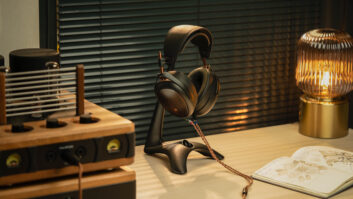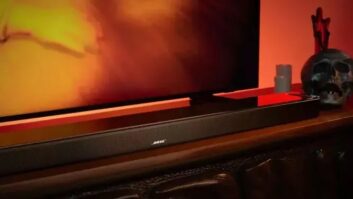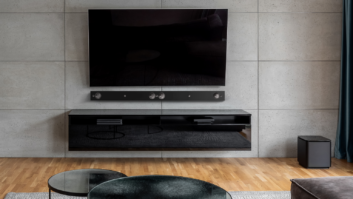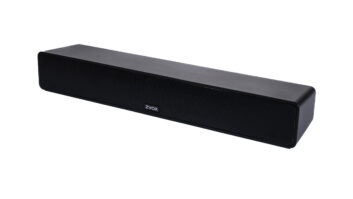LAS VEGAS —
GoldenEar Technology, which
launched its first home speakers in late 2010 and
expanded its selection at September’s CEDIA Expo,
is expanding its selection again with an International
CES introduction of a three-channel passive soundbar
and its second tower speaker with embedded
powered subwoofer.
The company is also added to its new Invisa custom-
speaker series with an in-ceiling model suitable
for use as the front channels in a home-theater system
as well use as surround speakers.
In its first year of shipping products, the company
said it signed up more than 125 U.S. dealers and set
up distribution in more than 10 export markets. The
company, co-founded by Sandy Gross, a co-founder
of Polk and Definitive Technology, launched its first
products in September 2010.
The line’s expansion, Gross
said, gives dealers an opportunity
to offer a full line and
step consumers up or down
while keeping them within the
line. It also enables different
dealers to focus on different
products depending on their
market’s needs, he added.
The new passive soundbar,
called the SuperCinema 3D
Array, is the company’s first
soundbar, which measures
49 inches wide by 4.75 inches
tall by 2.5 inches deep. It
uses technologies appearing
in the company’s other
speakers, including accordion-
like ribbon tweeters and
multi-vaned phase plugs on midrange/bass drivers
to deliver greater frequency response, dynamic range
and detail than competing models at the same price
points and with greater imaging width, depth and
height, the company said. It’s targeted to retail for
$999 when it ships in the spring.
The soundbar also features technology to minimize
inter-aural crosstalk in the 150Hz to 2,000Hz range
to improve front-stage width
and depth beyond what three
separate-but-closely-spaced
speakers can deliver, said
Gross. The technology is
based on Princeton University
research showing that “imaging
cues present in the front
stage are corrupted when
played through normal leftright
speakers and soundbars
when the speakers are placed
closely together,” he said.
The soundbar, sized for
48-inch-and-larger TVs, features
three drivers for each
front channel, each channel
consisting of two spider-legbasket
4.5-inch bass-midrange
drivers with multi-vaned phase plugs and one
high-velocity folded ribbon tweeter. The drivers are
enclosed in a piano-gloss black cabinet made from
aerospace–grade extruded aluminum with a marble powder-infused baffle and end caps.
The enclosure measures 4.74 inches
by 49 inches by 2.5 inches. Frequency
response is 80Hz to 35kHz with 92dB
efficiency.
The soundbar will give A/V specialty
stores “a product to sell that ties into
the products [active surround bars
with virtual-surround decoding] shown
in big-box stores but delivers specialtystore
performance levels,” Gross said.
A second new speaker is the Triton
Three tower, a smaller version of the
Triton Two three-way tower with built-in
subwoofer. The Two, launched at $1,249
each, will go to $1,449, likely this month,
because of the rising cost of raw materials
such as neodymium, the rising cost
of labor in China, and change in the exchange
rate of the Chinese yuan.
The Triton Three, also three-way, will
be priced at a projected $999 each
when it ships in the winter.
The Triton Two is designed for listeners
“looking for a somewhat less
imposing loudspeaker that offers
equally superb performance for both
high-quality two-channel systems as
well as in multi-home theater and music
systems,” said Gross. Like its bigger brother, it features curved design that
tapers backwards.
The Three is 44 inches high by 13
inches deep with a frequency response
of 20Hz to 35 kHz, whereas the Two is
48 inches tall and 15 inches deep with
a 16Hz to 35kHz frequency response.
The front of the Three and Two are
both 5.25 inches wide.
The Three comes with built-in 800-
watt DSP subwoofer instead of a 1,200-
watt sub, one active subwoofer driver
instead of two, and one cone midrange
driver instead of two. Both models feature
two passive bass radiators.
In custom speakers, GoldenEar said
it plans spring shipments of its first two
custom speakers shown at CEDIA and
the new Invisa home-theater speaker.
All feature magneticallQ attached flat
micro-perf grilles that hide the flange to
make the speakers virtually invisible. All
three models incorporate HVFR highfrequency
radiators.
The newest custom model, the twoway
Invisa Home Theater Reference
7000 at a projected $499 each, was
originally to be shown at CEDIA but
didn’t make it. It’s due in the spring.
The Invisa 7000 is designed as
a ceiling-mount left, right or center
speaker for home theater or music.
Shipping in the spring, it features a
10-inch round grille with a 7-inch bass/
midrange driver angled at 28 degrees
toward the listening position to deliver
what the company called “freestanding-
speaker-quality performance.” It
also features a pivoting tweeter that
can be angled more than 28 degrees to
reach listeners who are sitting farther
back than other listeners. The company
also said it took steps to optimize
the speaker to deliver “open, box-less,
three-dimensional imaging” that appears
to emanate from the front wall
rather than the ceiling.













